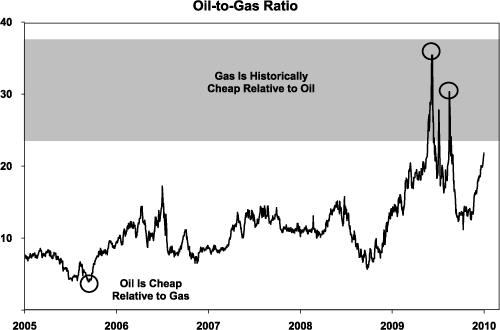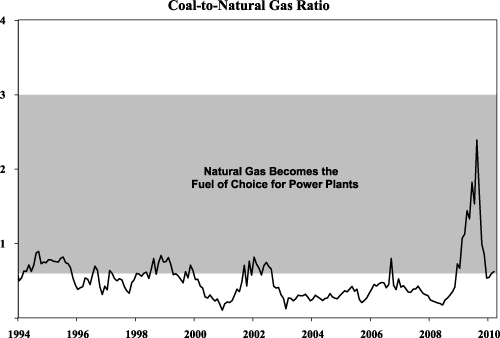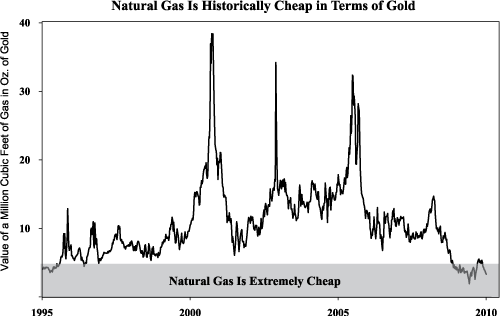| Home | About Us | Resources | Archive | Free Reports | Market Window |
|
Editor's note: Just a quick reminder that our introductory offer for DailyWealth Premium, closes tomorrow, Friday, April 9. For just $5 a month, you can get access to the best ideas (hand-picked by Dr. Steve Sjuggerud) from more than $35,000 worth of investment newsletters. The price will jump nearly 100% after Friday. Click here for the full details.
The Last Cheap Commodity LeftBy
Thursday, April 8, 2010
Your job just got a lot harder.
If you're a commodity investor, you've had a pretty good year. Over the last 12 months, in my S&A Resource Report portfolio, I've recommended 13 stocks that have gained 10%-99%, three stocks that have gained 100%-200%, and one stock that's up an incredible 460%.
Those are great results. But here's the thing: We've been buying gold stocks, silver stocks, and oil stocks. Over the last 12 months, gold is up 28%, oil is up 75%, and silver is up 48%. These rallies have provided a tremendous tailwind for resource stocks.
Now, our job as resource investors is getting difficult. After such a big price surge, there are few bargains left in the commodity space. But there is one market that hasn't soared. It's just about the only one. I think it's nearly as cheap as it's ever going to get... and I think it presents a fantastic opportunity...
The opportunity is in natural gas.
While oil is in the headlines constantly, natural gas bores most investors to tears. We use "natty" as the fuel for home heating and cooling, and for electricity generation. Over the past few years, new drilling techniques have dramatically increased U.S. natural gas supplies. From 1984 to 2009, U.S. natural gas production jumped 42%. But demand only increased 27%.
This surge of production, coupled with only a creeping increase in usage, has caused a crash in natural gas prices. Just a few years ago, $7-$8 per mcf (thousand cubic feet) was a normal price. Nowadays, $4-$5 is a normal price... and $3 to $3.50 is the "new cheap." Prices are currently in the $4 range.
Also placing natural gas in cheap territory is the oil-to-gas ratio. Natural gas is the "clean cousin" of crude oil. Sometimes oil gets cheap relative to natural gas; sometimes natural gas gets cheap relative to oil.
Since the gas glut hit, the oil-to-gas ratio has found a "new cheap" level between 20:1 and 24:1. (In other words, gas is cheap when 20,000 cubic feet of gas costs as much as one barrel of oil.)
 Today, the oil-to-gas ratio is 20:1 and rising. Natty is cheap relative to oil.
Natural gas is a government-approved long-term alternative to coal. So another good guide to "cheap" natural gas is the coal-to-gas ratio.
The government places tons of restrictions on burning coal (and more are on the way). Coal soot is full of harmful stuff – sulfur, nitrogen compounds, and metals (like mercury and lead). The EPA strictly limits these compounds. So power plants face three choices to limit that pollution – install an expensive filter to capture the pollutants before they leave the smoke stack, burn cleaner (but less efficient) coal... or use natural gas. When the natty price is right, power plants make the switch.
The coal-to-gas ratio measures the price of each fuel per million British thermal units (MMBTU). So when the ratio is 1, the amount of coal needed to generate one MMBTU costs the same as the amount of natural gas needed to generate one MMBTU.
When the ratio is below 1, burning gas costs more than burning coal. When the ratio exceeds 1, coal is more expensive. Typically, gas is too expensive relative to coal to justify the switch. The long-term average from 1993 to today is 0.5. But in late 2008, the price of coal began to rise just as the price of natural gas tanked. You can see the big spike in the ratio in the chart below.
 According to Platt's, which tracks the coal industry, power plants are making the switch. That will help create a floor for natural gas. As gas gets even cheaper relative to coal, the power industry will step up and increase its consumption.
Lastly, let's look at the price of natural gas in terms of gold. This allows us to view the value of natural gas in terms of "real money"... not the paper kind the U.S. government can debase at will.
 As the dollar has fallen, gold has appreciated in kind. Meanwhile, natural gas has plummeted in the past two years. This ratio illustrates the real-world cheapness of natural gas. Any way you look at it, natural gas is cheap. It's cheap next to its energy cousin, oil. It's cheap compared to its closest competitor, coal. And it's cheap measured in real wealth, gold.
One way to play this is with energy exploration companies that have the bulk of their assets in natural gas production. They offer big upside if natural gas prices pop higher... or if they score a big discovery.
A short list of quality U.S. companies with lots of natural gas exposure is: Southwestern Energy (NYSE: SWN), Ultra Petroleum (NYSE: UPL), Chesapeake Energy (NYSE: CHK), and Petrohawk (HK). Another interesting gas company is a Canadian producer called EnCana (ECA).
Good investing,
Matt
Further Reading:
Matt's not the only one who has noticed natural gas is outrageously cheap. ExxonMobil, run by some of the world's greatest energy investors, recently spent $41 billion buying America's second-largest natural gas producer. Tom Dyson wrote up the deal along with his favorite ways to follow in Exxon's footsteps. Get the story here: Thank ExxonMobil for These Solid 10% Dividends.
Porter Stansberry figures natural gas is one of the best ways to hedge your wealth against inflation – right up there with gold. A few months back, he sat down with our sister publication The Daily Crux to explain why... and the best ways to play it. This exclusive interview is absolutely free to access. You can learn how here.
Market NotesAS PREDICTED, THE VENTURE IS SOARING Today, we present to you, "as advertised," the bull run in the Canadian Venture Index.
You can view the Canadian Venture Index as the "Dow Industrials of small resource companies." The index is a gauge of the price action in small gold, silver, uranium, and energy stocks. Note the emphasis on "small"... These are not huge, stable companies like ExxonMobil... but riskier plays on mining and energy.
These riskier plays were clobbered during the 2008 credit crisis. It was after this crisis in December 2008 that we noted these stocks had enormous potential to rebound if the market got "less bad."
Well, the market got less bad... The government's inflationary efforts have pushed the prices of many commodities to fresh 52-week highs, and the "Venture" has skyrocketed. The index is up 129% since our writeup. In the short term, it's due for a breather... But long term, the government's inflationary boondoggle ensures this index – and many of the small exploration firms in it – are going much higher.
|
In The Daily Crux
Recent Articles
|

